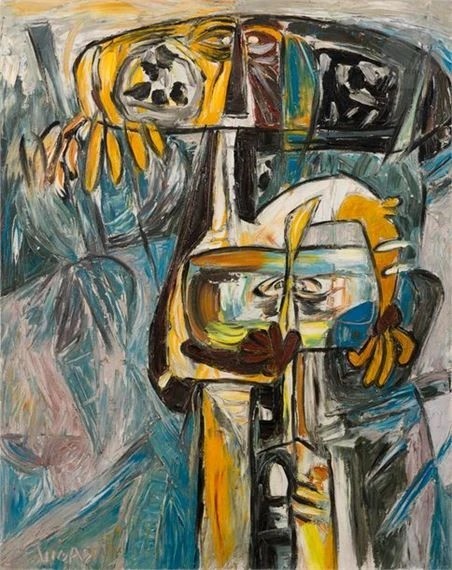André Derain, Matisse Et Terrus, Painted In 1905

André Derain, Matisse et Terrus, Painted in 1905
oil on canvas
40.3 x 54.3 cm. 15 7⁄8 x 21 3⁄8 in.
More Posts from Art0634 and Others

Jean-Michel Basquiat (American, 1960-1988), Untitiled, 1986. Acrylic on canvas, 150 x 120 cm.

Ad Reinhardt (american 1913 – 1967), Untitled, 1937
oil on wood


Benito Viliano Tarabella (1937-2003) - Testa in otto, 1974

Martyr Hill
Artist: O Louis Guglielmi (American, 1906-1956)
Date: c. 1933-1934
Medium: Oil on canvas
Collection: Smithsonian American Art Museum, Washington, DC, United States
Description
The eerie loneliness of Louis Guglielmi's painting Martyr Hill seems surreal. Yet the Grand Army of the Republic Hall in Peterborough, New Hampshire, actually looks much as it does in this painting. Guglielmi, who spent many summers at the MacDowell artist colony in Peterborough, knew the place well. He altered the scene slightly but effectively to create an uneasy, melancholy mood reflecting the troubles of the time.
Sweeping diagonal lines draw the viewer's attention to the GAR Hall, with its spiky finials and a cannon aimed to menace the viewer. In fact, the cannon stands on the opposite side of the hall’s lawn. Guglielmi removed the windows from the hall’s side wall, creating the solid red parallelogram he placed very near the dark front wall of the house in the foreground. This causes the eye to lurch disconcertingly from foreground to background. Nothing in the painting casts a shadow - the buildings therefore look oddly insubstantial. The sculpted bronze soldier on the Civil War Memorial, his head bent in sorrow, underlines the lack of a living person in the scene. The Nubanusit River flows under a bridge and out toward the viewer, who is left with no place to stand.

Carol Hunt

Takanori Oguiss 荻須高徳

Oswaldo Vigas, Iracunda, dated 1966
Oil on canvas
100 x 80 cm

Jean Dubuffet
Le malentendu

by Jean Arp, 1941
-
 starykorab liked this · 8 months ago
starykorab liked this · 8 months ago -
 albad liked this · 11 months ago
albad liked this · 11 months ago -
 thegermanpainter liked this · 11 months ago
thegermanpainter liked this · 11 months ago -
 snowangelsoul liked this · 11 months ago
snowangelsoul liked this · 11 months ago -
 art0634 reblogged this · 11 months ago
art0634 reblogged this · 11 months ago -
 art0634 liked this · 11 months ago
art0634 liked this · 11 months ago -
 villasugandhala reblogged this · 11 months ago
villasugandhala reblogged this · 11 months ago
